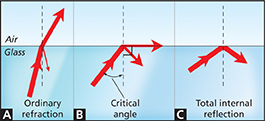Total Internal Reflection
A relatively new and very important application of refraction is fiber optics. Light rays are generally unable to exit through the sides of the curving fiber optic strands. Because of this, fiber optics are very useful for carrying information in the form of light. Figures 11A through 11C explain how fiber optics work.
As shown in Figure 11A, a light ray exiting from glass into air is refracted. Figure 11B shows that as the angle of incidence of the exiting ray increases, an angle known as the critical angle of refraction is reached. The critical angle is the angle of incidence that produces an angle of refraction of 90 degrees. At the critical angle the light ray bends so much that it takes a path along the glass-air boundary. Figure 11C shows that at angles larger than the critical angle, the light ray bends so much that it is reflected back into the glass. This situation is known as total internal reflection. Total internal reflection is the complete reflection of a light ray back into its original medium.
 Materials that have small critical angles are likely to cause most of the light entering them to be totally internally reflected. Such materials include diamond and the type of glass used in fiber optic strands. By making use of total internal reflection, fiber optics are able to transmit data in the form of light pulses over large distances with little loss in signal strength. To learn more about fiber optics, see page 586.
Materials that have small critical angles are likely to cause most of the light entering them to be totally internally reflected. Such materials include diamond and the type of glass used in fiber optic strands. By making use of total internal reflection, fiber optics are able to transmit data in the form of light pulses over large distances with little loss in signal strength. To learn more about fiber optics, see page 586.
Figure 11 Fiber optics make use of total internal reflection. A When a ray hits the glass-air boundary at an angle less than the critical angle, it is partly refracted and partly reflected. B At the critical angle, the angle of refraction is 90 degrees. C When the critical angle is exceeded, all of the light is reflected—total internal reflection occurs.
 d
dSection 19.2 Assessment
Reviewing Concepts
 What causes light rays to bend?
What causes light rays to bend? Why can concave lenses form only one type of image?
Why can concave lenses form only one type of image? What type of images are formed by concave lenses? By convex lenses?
What type of images are formed by concave lenses? By convex lenses? Most of tue light entering what type of material is likely to be totally internally reflected?
Most of tue light entering what type of material is likely to be totally internally reflected?Comparing and Contrasting How is a convex lens different from a concave lens? How are they the same?
Applying Concepts Explain how a convex lens is similar to a concave mirror.
Critical Thinking
Connecting Concepts
Speed of Light In Chapter 18, you learned that light travels at 3.00 × 108 m/s through the air. This speed is the product of frequency and wavelength (Speed = Frequency × Wavelength). Use this equation to show that the wavelength of the light changes when it passes from air to water. (Hint: The speed decreases and the frequency does not change.)




